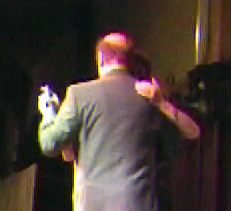Learning the Stance of Reaction, Part 1: Tango
I’ve been speaking about the desirability of what I call the stance of reaction in software development. Now it’s time to think about how to learn it. Since one of my inspirations for it is tango, I’ll first talk about how tango is learned. (This post may be tedious for people who don’t care about tango or teaching physical actions.)
Dawn and I took a tango lesson last night. It’s a just-beyond-beginner course concentrating on the milonga and vals, two alternate tango rhythms, but it was also teaching new figures to many of the students.
Here’s the first figure, which is one you can repeat an arbitrary number of times as you proceed sideways down the floor:
Joe and Carlotta (the instructors) began by demonstrating the figure, then explained just a few things to attend to. (Joe will usually say something about which part of the leader’s body signals the next movement to the follower. Carlotta usually talks about where and how the follower’s feet should land so as to be ready for the next step.)
 What happened next was typical: everyone practiced the movement separately with Joe and Carlotta making a few comments. We moved quickly to direct practice in a mixer: you meet a partner, go sideways down the floor, separate, meet up with a new partner, and continue. Most of us aren’t confident enough to correct our partners, but it’s usually pretty easy to tell how you’ve gotten it wrong and correct it yourself. It’s also easy to tell by feel when you’ve gotten it right.
What happened next was typical: everyone practiced the movement separately with Joe and Carlotta making a few comments. We moved quickly to direct practice in a mixer: you meet a partner, go sideways down the floor, separate, meet up with a new partner, and continue. Most of us aren’t confident enough to correct our partners, but it’s usually pretty easy to tell how you’ve gotten it wrong and correct it yourself. It’s also easy to tell by feel when you’ve gotten it right.
Joe and Carlotta observed, as usual. After two or three songs finished, they pointed to some things most of us could have done better. I don’t think we practiced this figure again; sometimes we do.
That typical practice session finished, they then introduced a new figure that can be combined with the first one. Instead of going backwards after the second step, the leader can take the couple to the right for one or more steps, then backward:
 This figure makes it harder for the follower. After two steps, she has to be prepared either to step forward or to her left. The leader signals this mostly by just moving in the direction he wants the couple to go, which I think the follower detects mostly via her arm on his shoulder.
This figure makes it harder for the follower. After two steps, she has to be prepared either to step forward or to her left. The leader signals this mostly by just moving in the direction he wants the couple to go, which I think the follower detects mostly via her arm on his shoulder.
We went quickly into another mixer. In this one, leaders were encouraged to switch between the two figures at unexpected moments. So the followers were learning to detect the lead, and the leaders were learning to make it clear enough to be detectable.
The next figure starts at the same position but deviates in a different direction. Instead of stepping forward once, bringing the feet together, and then changing direction, the leader repeats the first two steps:
After that, he can take the couple backwards (as in the original figure), to the right (as in the second) or, if there’s room, continue diagonally forward with the first two steps.
At this point in the lesson, I think we danced several songs in the normal “line of dance” (in a rough counterclockwise circle around the room, rather than down a straight line), switching partners between songs or at most once a song. (Tango songs are usually in the 2-4 minute range.) Using the line of dance approaches non-practice dancing more closely: there’s more time to adjust to a particular partner, and also the leader must avoid more collisions than in a line. (Learning to react to events while preserving your musicality is an important part of tango.)
All that lasted about a half an hour. Then there was open practice. Dawn and I concentrated somewhat on the figures we’d just practiced, but I threw in other variations and also figures that don’t start with the same step. These figures were easy enough that we could just have fun.
Dawn and I also practice in our basement and on our driveway (which I’m sure the neighbors think is terribly cute). We concentrate on what we’ve learned recently. (All these variations are hard to remember!) We’ll often practice the fine points of steps and body orientation in slow motion, then at normal speed. We also just plain dance, though the two spaces aren’t very good for that.
There are weekly to biweekly come-one-come-all practice sessions that Dawn and I usually attend. We do the same sort of practicing as above, but we have the advantage of experienced people we can ask for tips.
After almost a year, we should probably be dancing at real dances, but they’re usually pretty crowded and we’re not so experienced in the steps that work in that kind of a crowd. Also, neither of us is a particularly social animal.
